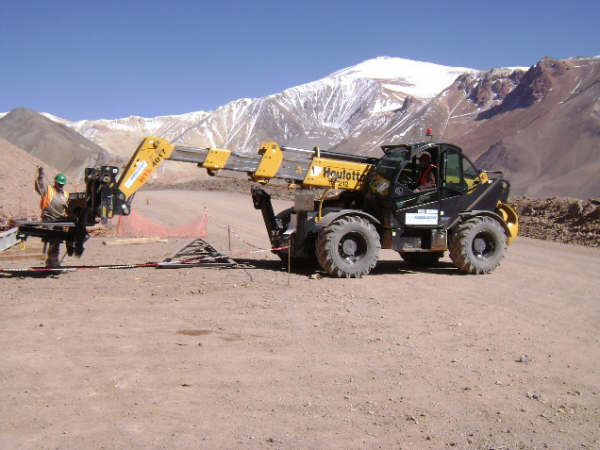 Haulotte's HTL 4017 working at 4000m altitude in an Argentine mine. |
Telehandlers are counterbalanced forklifts with telescopic booms that can achieve tasks that are beyond the abilities of straight-masted forklifts. As
Christine Cranney reports, built to traverse rough terrain and reach far and high, in and out of buildings, ships and trains, it is no mere marketing hype when their makers call them flexible and versatile machines.
Telehandlers largely owe their versatility to the attachments and accessories that enable them to load, lift, carry a range of materials, mix concrete or even lift people.
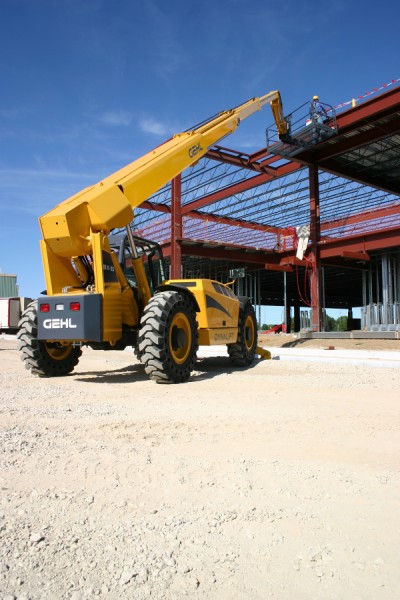 A Gehl telehandler with a personnel basket attachment. |
Telehandlers with tynes can move and place palletised bricks, blocks and other building and construction materials. Telehandlers with buckets can move loose material like sand, soil, gravel, grains, scrap metal, wood chip and debris around construction and agricultural sites. Lastly, telehandlers with jibs and lifting hooks become hoists and are used to lift and place suspended loads in construction sites.
David Single of access equipment designer, manufacturer and marketer JLG Australia says that with attachments, telehandlers can reduce the workload in construction, agriculture and maintenance tasks.
"[From] site preparation to site completion, the model may change from a very agile rough-terrain telehandler that unloads trucks, to a high-reach 17 metre (56 foot) unit with outriggers and a jib boom. The last telehandler on site may be a smaller compact unit used to clean up inside the structure and around the site."
He adds that the handling of construction waste is now a function of telehandlers with buckets and rubbish grabs.
French aerial work platform specialist Haulotte Group produces the HTL 4014 and HTL 4017 telehandlers, which, it claims, have some of the best lifting heights in the market.
Haulotte Group product manager Cyrille Arrourart attributes the telehandlers' versatility to the equipment's high base level, which allows them to work with all types of attachments, from tynes to working platforms.
"The Haulotte telehandlers integrate every technological innovation developed in the field of aerial work platforms," he adds. Haulotte, one of the world's leading aerial work platform manufacturers, entered the telehandler market in 2007.
Gehl Company product and training specialist John Rau says all industrial applications need maintenance and a telehandler is easily converted into a limited aerial lift application by attaching a passenger basket on the front of the machine, eliminating the need for an aerial lift and a telehandler.
Meanwhile, DIECI srl, which has been manufacturing telehandlers in Italy since 1982, says its Pegasus rotating boom telehandlers, which are the "pride and joy" of the company, are perfect multi-taskers as they can be kitted out with a variety of attachments.
Telehandlers vs other equipmentAUSA Center SLU's product strategy manager Xavier Perramon says telehandlers are "functionally speaking" more versatile than their closest competitors - skid steer loaders and wheel loaders.
"Its main advantages are higher load capacity and lifting height, better reaching ability due to its telescopic boom, higher load stability provided by its rigid and long-wheel base chassis, and easier operator access to the cabin," he explains.
Maye Houck, Caterpillar Alliance Group's global marketing communications manager adds that "unlike skid steer loaders or even a ladder", telehandlers allow users to place their load with precision.
Telehandlers rarely work on "billiard-table smooth" surfaces. Able to work on unpaved surfaces that pose challenges for normal counterbalanced forklifts, the telehandler is a rough-terrain machine with four-wheel drive, four-wheel steer, and excellent traction and ground clearance. They can be the first on the site and the last to leave as they clean up the site.
Rau says telehandlers are the only forklifts that use three modes of steering to accomplish tasks. The four-wheel, crab and front-wheel modes increase productivity when manoeuvring in all applications. For increased productivity, telehandlers also have forward reach for loads that are far from the machine. Straight-masted forklifts only work on a straight, vertical plane.
New developmentsThere are two ways in which telehandlers evolve. Manufacturers can develop new attachments to meet customer needs or boost the forklifts' efficiency and hence user productivity.
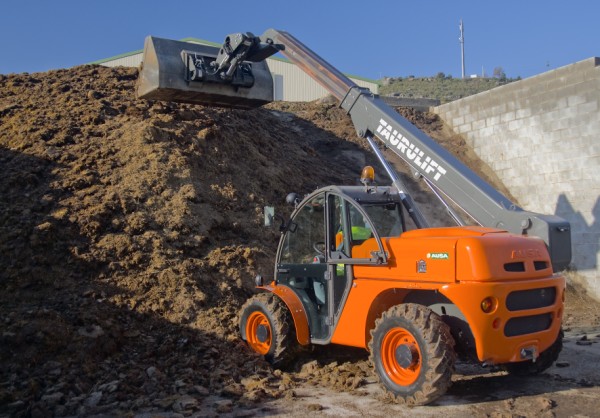 The T276H telehandler is a part of AUSA's Taurulift range. |
The latter is evident in the current industry trend of developing smaller machines while maintaining or increasing their lift height and capacity.
Single explains that modern construction and processes make smaller telehandlers a necessity.
"Modern, multi-storey car park construction lends itself to the super-compact units that have a smaller footprint, and stowed height and gradability to climb the entry and exit ramps with the rated load," he says.
AUSA of Barcelona, Spain launched telehandlers in 2007 and claims its Taurulift telehandler concept is "ultra compact" compared to other telehandlers. Perramon boasts that the compact telehandlers have "excellent access for maintenance, integrated under-cab air-conditioning and maximum nominal capacity from zero to maximum lifting height".
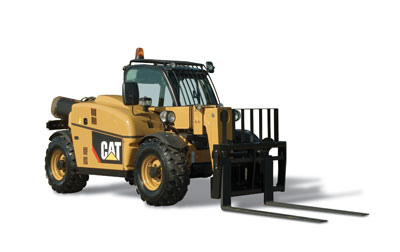 The Cat TH255 "super compact" telehandler |
Caterpillar's recent telehandler innovation is the TH255 "super-compact telehandler". Its 3.2 metre (126 inch) turning radius enables it to manoeuvre in tight quarters while a low-profile hood, side-mounted engine and mid-mounted cab give it enhanced all-round visibility. It comes as standard with a universal skid steer loader-style coupler or an optional telehandler-style coupler system.
Houck says compared to a skid steer or compact wheel loader, the TH255 offers "superior extended reach and lift height".
DIECI's Apollo 25.6 fixed-boom telehandler is a "mini-handler" designed to meet light-duty requirements and work in tight and awkward spaces like cellars and underground car parks. Its maximum capacity is 2,500kg (5,512lbs), has a maximum lift height of 5.78 metres (19 feet), and total empty weight of 4,800kg (10,582lbs).
In Australia, regulations governing the use of telehandlers were formerly based on European Standard EN1459 requirements, designed mainly for typical rough-terrain forklift operations. New regulations, the Australian Standard for Telehandlers AS 1418-19-2007, are broader in scope, recognising the frequent use of telehandlers as non-slewing mobile cranes.
All telehandlers in Australia are now regarded as cranes when using a jib or hook attachment for handling suspended loads and must provide the same level of safety as a crane.
New market entrantsAUSA's Perramon says the number of competitors "is already very large" and does not foresee new companies with new developments entering the market in the next five years.
"It is more probable that new entrants with telehandlers will increase their portfolio by means of manufacturing agreements with makers of existing models."
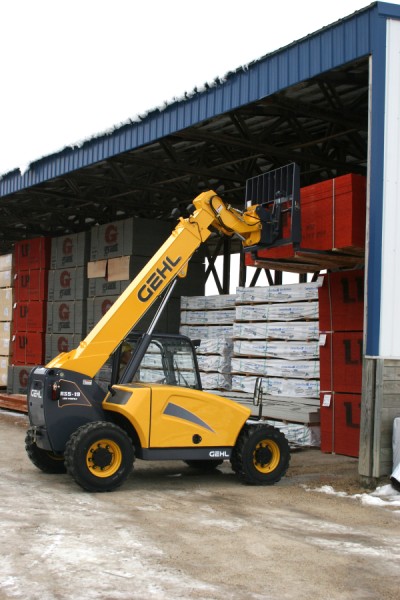 A Gehl telehandler moving materials in a warehouse. |
Product manager Brian Rabe says Gehl's focus is on improving its current and future telehandler models, and new competitors "just force existing manufacturers to fall back on their market experience", to improve the core strengths of their product line.
Haulotte's Arrourart says new entrants from Asia could pose a challenge but thinks that they will focus on their domestic markets, like China where the demand is significant.
Single cautions new entrants to the Australian market to ensure their telehandlers comply with Australian standards: "Importing of European- or US-specification telehandlers without the required safety devices and load charts puts the whole industry at risk."
All telehandlers built since October 2007 are subject to the Telehandler Safe Use Standard (AS 2550 Part 19) in Australia, and are subject to daily pre-start checks, routine maintenance, periodic inspections and a 10-year major inspection.
Effect of global recessionThe slowdown in the construction industry has had a large impact on all telehandler manufacturers. All have taken measures to cut costs and adapt to the changing market while one company
Forkliftaction.com News spoke to is preparing for an important product launch this year.
Caterpillar has been "investing more time ensuring our customers have the machines they need". While there has been less demand for new machines, it has been imperative for the company to take care of existing customers by ensuring their telehandlers are running efficiently through aftermarket parts, service centres and training.
Rabe says flexibility has enabled Gehl to survive in a down economy. "[It] forces us to actively promote our product to other business sectors. We continuously have to adapt our product and training to fit end users. This is what being in the business 150 years teaches you." (The Gehl Company's roots date back to 1859 when its founder opened an iron foundry in Wisconsin, USA. The business was established to manufacture plows and cultivators, and to repair farm implements.)
Haulotte has limited its investment to projects that "offer strategic potential for the future" besides reducing inventory levels and overhead expenses. "These measures should make it possible to reduce the group's breakeven point and limit the level of debt," Arrourart says.
Nevertheless, Haulotte has not modified its long-term strategy and continues to pursue the development of its worldwide sales network and R&D efforts. Arrourart says: "Effectively preparing for the future is more than ever our priority to ensure we will be well-positioned to meet the needs of our customers as the market recovers."
Perramon says AUSA Group has been "sensitively affected by the financial downturn". However, in order to counter its effect, it has been forced to take "measures of a different kind" to adapt the company to its new circumstances.
AUSA has invested "a significant percentage of its turnover" in innovation and will launch what it claims is the most compact telehandler in the market at leading construction machinery expo, Bauma 2010.
Gehl Europe GmbH, JLG International and DIECI srl will also be exhibiting at Bauma 2010, from 19-25 April at the New Munich Trade Fair Centre in Munich, Germany. Haulotte Group has decided to focus on open days for its subsidiaries instead and will exhibit at Bauma China, in November 2010. Currently, organiser Messe München estimates that over half of the Munich show's exhibitors are from outside the country. In 2007, over 500,000 visitors from all over the world visited Bauma.